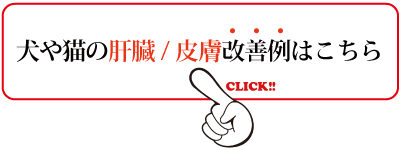### What Types of Liver Diseases Do Cats Have?
#### Main Liver Diseases in Cats (Excluding Tumors like Liver Cancer)
This section outlines the causes, symptoms, and treatments for the primary liver diseases in cats, apart from tumors such as liver cancer.
Research is ongoing to understand how treatments like placental extract and Cordyceps may improve liver conditions by boosting the immune system, even if a cat develops liver disease.
- Cholangiohepatitis is the most common chronic inflammatory disease affecting the liver and bile ducts in cats.
- Extrahepatic bile duct obstruction does not occur on its own but is caused by other underlying conditions.
- For the recovery of energy and appetite, administering domestically produced SPF pig-derived placental powder for 1-2 months may show improvement.
### Acute Hepatitis
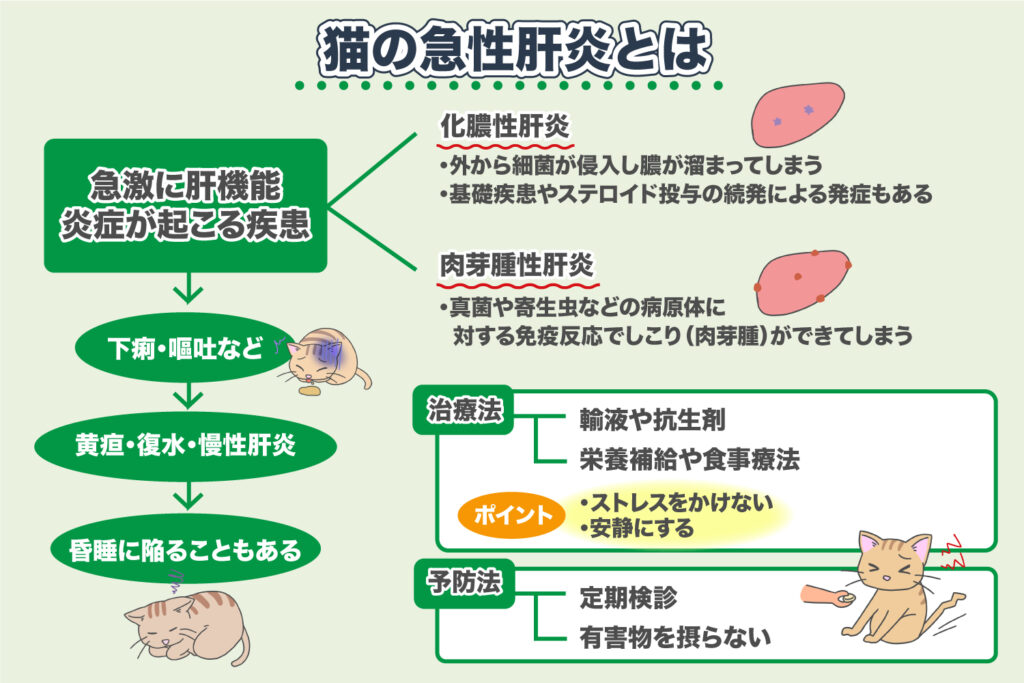
Acute hepatitis can be classified into “suppurative hepatitis,” caused by bacterial infections leading to pus formation, and “granulomatous hepatitis,” where an immune response to a pathogen results in granuloma formation.
Suppurative hepatitis is caused by the invasion of external bacteria.
Cholangiohepatitis, diabetes, Cushing’s syndrome (hyperadrenocorticism), and excessive steroid use can also lead to its development.
Granulomatous hepatitis can be due to feline infectious peritonitis (FIP), fungi forming granulomas, parasites, and, in rare cases, tumors or lymphangiectasia.
Both conditions can present with gastrointestinal symptoms such as diarrhea and vomiting.
Jaundice, ascites, and progression to chronic hepatitis may occur, with the worst-case scenario leading to coma.
### Treatment Methods
The goal is to alleviate symptoms through fluid therapy and antibiotics.
Additionally, nutritional support and dietary therapy are provided, and the patient is kept stress-free and at rest.
### Dietary Therapy
For dietary therapy, please refer to [these ingredients that support liver function](https://cordy-en.com/maintain-liver-function/#syokuji).
Additionally, the anti-inflammatory effects of [placenta](https://cordy-en.com/dog-cat-placenta2/) can also be expected to alleviate symptoms.
### Prevention
Regular check-ups and avoiding the intake of harmful substances are recommended.
### Chronic Hepatitis, Liver Cirrhosis, and Liver Fibrosis
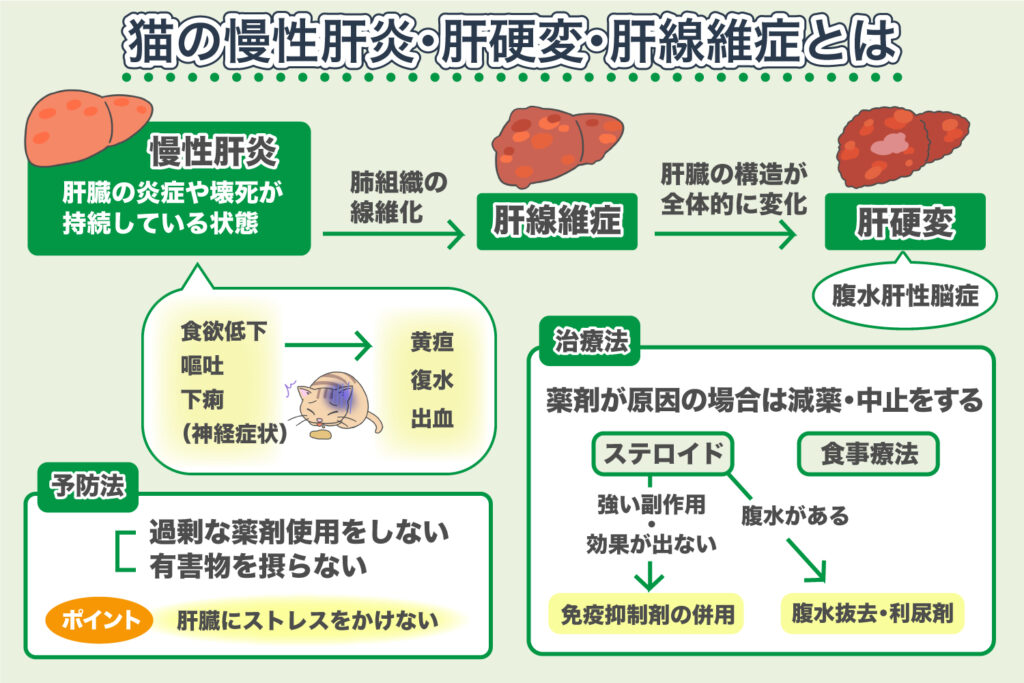
As chronic hepatitis progresses, the liver tissue becomes fibrotic, leading to liver fibrosis, and if this condition is prolonged, it results in liver cirrhosis where the overall structure of the liver changes.
In liver cirrhosis, because blood flow within the liver is hampered, it ultimately leads to conditions like ascites and hepatic encephalopathy.
While it often presents without symptoms, generally, there are symptoms such as appetite loss, vomiting, and diarrhea. As it progresses, jaundice, accumulation of ascitic fluid, and a tendency to bleed may be observed.
Moreover, impaired liver function can lead to the inability to detoxify substances like ammonia, resulting in neurological symptoms like hepatic encephalopathy.
### Treatment
If chronic hepatitis is due to medication, it is necessary to reduce or discontinue the medication.
If side effects are severe or the effects are insufficient, inflammation is controlled by combining immunosuppressants.
If ascites is present, the fluid can be removed by inserting a needle or by promoting fluid excretion with diuretics.
Additionally, as a dietary therapy, a protein-restricted diet is fundamental to reduce ammonia production.
There are two types of proteins: animal and plant-based. Plant-based proteins are easier on the liver compared to animal proteins, so it might be beneficial to include a slightly higher proportion of plant-based proteins.
However, dogs and cats require more protein than humans, so utilizing [BCAAs](https://cordy-en.com/bcaa/), which are protein breakdown products in the form of amino acids, is recommended.
Also, the [liver cell growth factor (HGF) contained in placenta](https://cordy-en.com/dog-cat-placenta2/) can aid in the decomposition and removal of fibrotic liver tissue.
目次
Prevention
It is important to avoid excessive use of medications and intake of harmful substances (such as additives) to prevent putting strain on the liver.
Cholangitis and Cholangiohepatitis
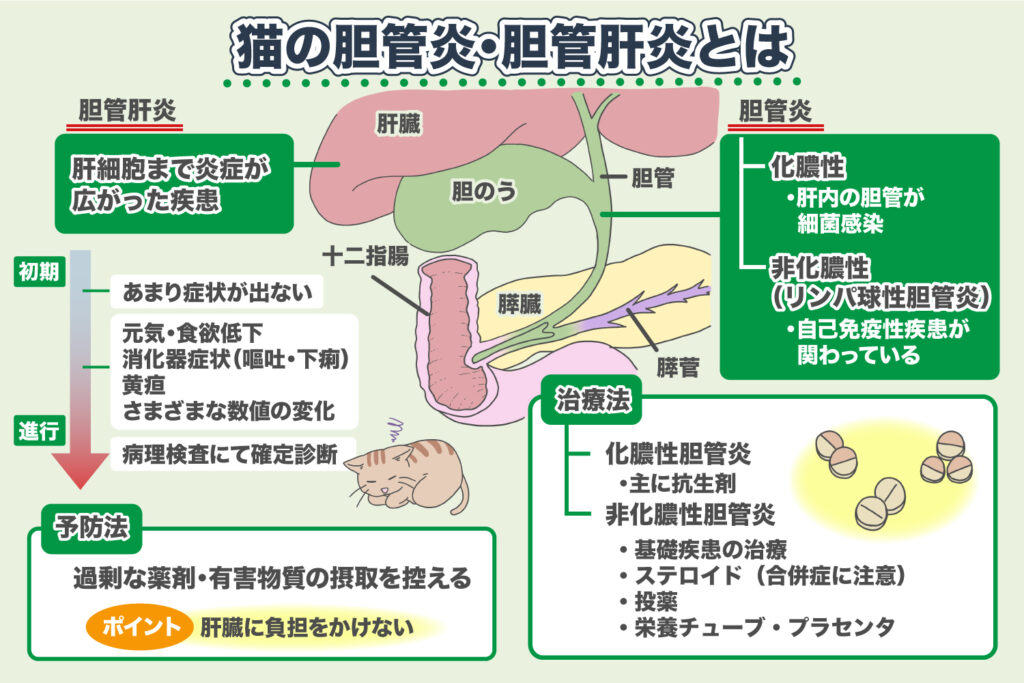
Cholangitis can be categorized into suppurative (caused by bacterial infections such as E. coli, β-hemolytic streptococci, Klebsiella, Actinomyces, and Clostridium) and non-suppurative (no bacterial infection).
Suppurative cholangitis results from the infection of intestinal bacteria from the extrahepatic bile ducts to the intrahepatic bile ducts.
Non-suppurative cholangitis, also known as lymphocytic cholangitis, is believed to be associated with autoimmune diseases.
Similar to hepatitis, there are often no significant symptoms in the early stages, and even if blood tests show elevated liver values, imaging tests usually do not reveal any changes.
As the disease progresses, symptoms such as decreased energy and appetite, digestive symptoms like vomiting and diarrhea, and jaundice may appear. Blood tests may show elevated total bile acid levels as well as decreased levels of albumin (Alb) and blood urea nitrogen (BUN).
For a definitive diagnosis, liver tissue samples are collected via laparoscopy and submitted for pathological examination.
Treatment
In cases of suppurative cholangitis, the primary treatment involves the use of antibiotics to address the bacterial infection.
However, indiscriminate use of antibiotics can lead to the development of antibiotic-resistant bacteria, so it is recommended to select appropriate antibiotics based on bacterial culture of liver tissue.
For non-suppurative cholangitis, treating underlying conditions in other organs is prioritized, with the use of steroids to suppress inflammation.
Since steroids are also immunosuppressants, long-term use can lead to complications such as diabetes or bacterial infections. It is crucial to administer steroids while closely monitoring the patient’s condition through regular blood tests.
Additional treatments may include administration of antioxidants and liver protectants.
For cats with poor appetite, there is a risk of concurrent hepatic lipidosis, so placement of a feeding tube in the stomach or esophagus may be considered.
Furthermore, the anti-inflammatory effects of placenta may help alleviate symptoms.
Prevention
Avoid excessive use of medications and intake of harmful substances (such as additives) to prevent putting strain on the liver.
Here are some foods that support liver function.
Extrahepatic Bile Duct Obstruction

It can be classified into extraluminal compression and intraluminal obstruction. Extraluminal compression refers to the condition where the bile ducts are compressed from the outside due to inflammation, tumors, or trauma, while intraluminal obstruction refers to the condition where gallstones or concentrated bile block the ducts.
Symptoms vary depending on the underlying disease, but generally, loss of appetite and jaundice are common.
Due to the inability to effectively excrete bile, it is also characteristic for stools to become pale (grayish-white).
Since bile is involved in the synthesis of proteins related to blood coagulation, bleeding tendencies may also be observed due to bile secretion deficiency.
Treatment Methods
In cases of partial obstruction, medication may improve the condition; however, if there is no improvement or in cases of complete obstruction, biliary bypass surgery or stent placement is performed to widen the duct and relieve the obstruction.
Additionally, since bile insufficiency can cause malabsorption of fat-soluble vitamins, subcutaneous administration of vitamin K may also be carried out.
Please see here for dietary ingredients that can actively support liver function as part of dietary therapy.
Prevention Methods
To prevent underlying diseases, it is important to provide a proper diet, exercise, and a stress-free lifestyle on a daily basis.
Portosystemic Shunt (PSS)
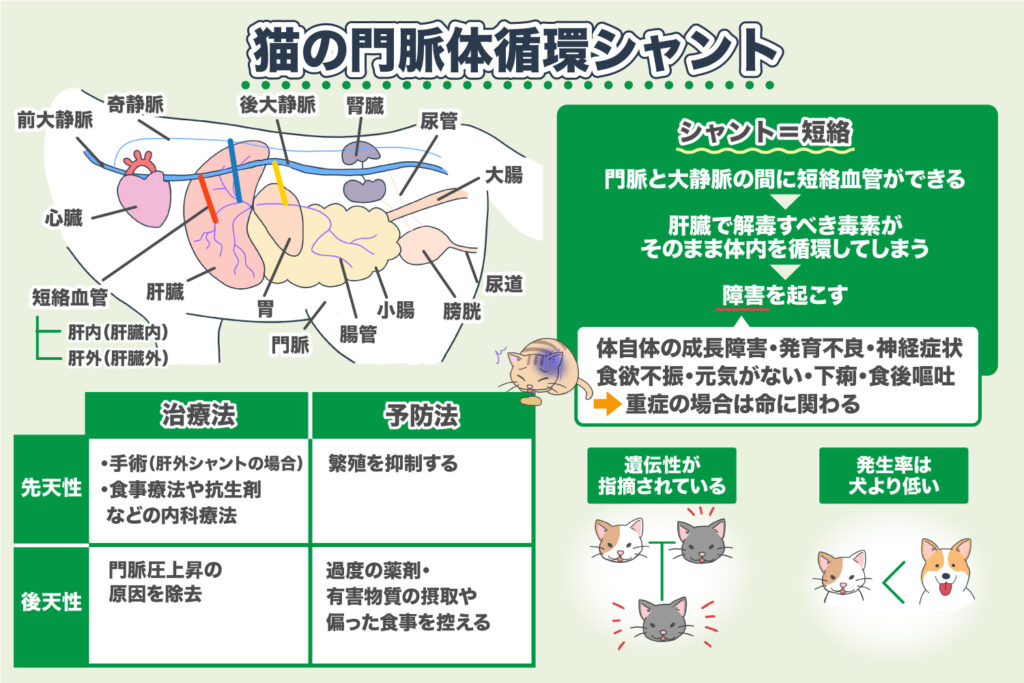
The toxins, such as ammonia, which are meant to be detoxified in the liver, enter the systemic circulation without being detoxified due to the shunt vessel, causing toxin-related damage to the body.
Additionally, the inability to supply adequate blood to the liver results in underdevelopment of the liver and impaired function, leading to growth disorders in the body itself.
Shunt vessels can be located inside the liver (intrahepatic) or outside the liver (extrahepatic). In cats, extrahepatic shunts are more common, and there are surgical techniques to close the shunt vessel using special instruments.
Compared to dogs, the incidence of portosystemic shunts in cats is said to be lower.
Most cases are congenital (present from birth), causing poor development and neurological symptoms.
Cats with portosystemic shunts exhibit growth retardation when compared to their littermates, fail to gain weight, and show symptoms such as loss of appetite, lethargy, diarrhea, postprandial vomiting, and neurological symptoms (drooling, aimless wandering, seizures, convulsions). In severe cases, it can be fatal.
Since genetic factors are suggested, one of the preventive measures is to avoid breeding dogs that might carry the genes for portosystemic shunts.
### Acquired Portosystemic Shunt
An acquired portosystemic shunt appears when blood pressure in the portal vein increases due to liver dysfunctions such as cirrhosis, hepatic fibrosis, chronic hepatitis, or bile duct obstruction, causing blood congestion in the liver.
Ultrasound examination is highly effective, and CT scans can also evaluate the portal vein.
Treatment Methods
As mentioned earlier, surgery can be effective in cases of extrahepatic shunt.
In terms of medical therapy, to prevent hepatic encephalopathy, ammonia production is controlled through protein-restricted diets, antibiotics, and lactulose.
For acquired cases, surgery is generally considered inappropriate, making the removal of the cause of elevated portal pressure crucial.
Prevention Methods
For congenital cases, it is suggested to prevent breeding to avoid the proliferation of offspring with portosystemic shunt, due to its hereditary nature.
For acquired cases, to prevent causes of elevated portal pressure, it is necessary to avoid excessive medication, harmful substances, and unbalanced nutrition intake.
Additionally, in breeds prone to the condition, regular checkups for early detection are also important.
### Hepatic Lipidosis
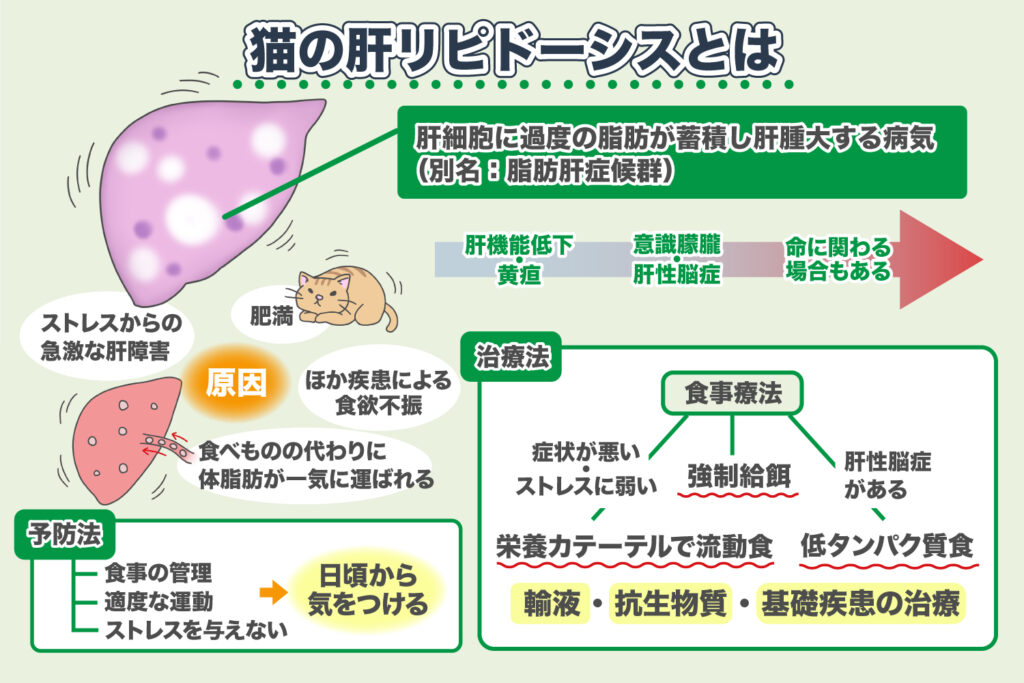
Also known as fatty liver syndrome, it is a condition where excessive fat (triglycerides, neutral fats) accumulates in the liver cells.
The accumulation of fat in the liver leads to hepatomegaly.
Liver function declines, bile stasis occurs, leading to jaundice, and in severe cases, there can be mental disorientation, hepatic encephalopathy, and potential fatality.
Obesity is one predisposing factor, but it can also result from other diseases causing bile duct inflammation or appetite loss, and sometimes stress can trigger rapid liver damage.
Blood tests show elevated liver values, triglycerides, and cholesterol, and if jaundice is present, total bile acid values will also be elevated.
If neurological symptoms such as mental disorientation or hepatic encephalopathy are observed, ammonia levels will also be high.
Radiographs may reveal hepatomegaly but cannot provide a definitive diagnosis. If echography shows a whitish liver, hepatic lipidosis is suspected.
For a definitive diagnosis, liver cells are extracted under echography to confirm fat accumulation and hepatomegaly via microscopic examination.
Treatment Methods
Forced feeding is often performed, but for severely ill cats or those who are sensitive to stress, forced feeding might further deplete their strength. In such cases, nutritional catheters are placed in the nose, neck, or stomach to administer liquid food.
### Translation
In cases of feline hepatic encephalopathy, excessive protein intake can exacerbate symptoms, so initially, a diet with controlled protein levels is provided.
Depending on the symptoms, intravenous fluids and antibiotics may also be used, and if there are other underlying conditions, treatments for those will be conducted simultaneously.
Additionally, for dietary therapy to support liver function, please refer to [these ingredients](https://cordy-en.com/maintain-liver-function/#syokuji).
### Preventive Measures
If unexplained loss of appetite persists, it’s important to have your pet checked as soon as possible.
## Feline Infectious Peritonitis (FIP)

Feline Infectious Peritonitis Virus (FIP virus) results from a mutation of the feline coronavirus in the intestines.
Presently, there is no cure, and it remains an incurable disease with only palliative treatments available.
It commonly develops in young or elderly cats, but any cat carrying the coronavirus is at risk of developing FIP.
It is estimated that half of the cats in Japan are asymptomatically infected with feline coronavirus (infected but showing no symptoms).
To prevent mutations, it is crucial to minimize stress and maintain the immune system.
Symptoms include fever, gastrointestinal issues such as loss of appetite and vomiting, dehydration, and anemia. As the condition progresses, liver dysfunction can occur, and accumulation of abdominal fluid or chest fluid can cause abdominal distension, which can compress the chest and lead to respiratory distress (wet form: effusive type).
In the dry form (non-effusive type), neurological symptoms such as paralysis, hyperesthesia, epileptic seizures, and personality changes, as well as eye issues like iritis and uveitis, can manifest. Vomiting, constipation, and jaundice related to organ impairment may also be observed.
### Treatment
As it is incurable, the focus is on symptomatic and palliative care to maintain quality of life (QOL).
Interferons and steroids may be used, and treatments to alleviate various symptoms (such as anti-nausea, anti-diarrhea, and pain relief medications) may also be administered.
For immune support, Cordy is recommended.
To support liver function, [placenta](https://cordy-en.com/dog-cat-placenta2/) is also considered effective.
For dietary therapy, please refer to [these ingredients](https://cordy-en.com/maintain-liver-function/#syokuji) which help support liver function.
### Preventive Measures
The primary prevention is to avoid stress.
For indoor cats, it is also important to maintain the hygiene of their living space, such as disinfecting their environment and keeping their litter boxes and dishes clean.
Please also visit the Feline Infectious Peritonitis (FIP) page.
The liver is one of the most important organs in the body. By reducing the burden on the liver, you can also expect to maintain the health of your dog or cat.
Improving their diet is useful both as a treatment and as a prevention measure. As additional support, we recommend using placenta.
Incorporate foods that support liver function and use Placenta Kiss Powder derived from domestically-produced SPF pigs to aim for a healthy body for your dog or cat.
For more information on Placenta Kiss Powder derived from domestically-produced SPF pigs, click here.
Harness the power of immunity for cat liver cancer and liver disease
For those concerned about your cat’s liver or whose cat is already suffering from a liver disease.
There is a possibility of improvement by administering Placenta Kiss Powder derived from domestically-produced SPF pigs for 1 to 2 months to help recover vigor and appetite.
If liver function improves, you can continue using Placenta Kiss Powder derived from domestically-produced SPF pigs while gradually reducing the amount, which not only helps rejuvenate the liver but also improves skin condition and coat quality.
If you have any questions about Placenta Kiss Powder derived from domestically-produced SPF pigs, BCAA, or krill oil (EPA/DHA oil extracted from Antarctic krill), please feel free to contact us.
監修獣医師:林美彩 所属クリニック:chicoどうぶつ診療所

代替療法と西洋医学、両方の動物病院での勤務経験と多数のコルディの臨床経験をもつ。 モノリス在籍時には、一般的な動物医療(西洋医学)だけでは対応が困難な症例に対して多くの相談を受け、免疫の大切さを痛烈に実感する。
ペットたちの健康維持・改善のためには薬に頼った対処療法だけではなく、「普段の生活環境や食事を見直し、自宅でさまざまなケアを取り入れることで免疫力を維持し、病気にならない体づくりを目指していくことが大切である」という考えを提唱し普及活動に従事している。
所属:
- Usage Example of Placenta Extract Derived from Domestic SPF Pigs
- Recovery Case of a Dog with Poor Liver Values (Improvement in Cognition, Thyroid Function, Liver Function)
- Case of Improved Liver and Kidney Function in a Dog Using Placenta
- Six Cases of Improved Liver Function in Dogs and Cats Using Placenta
- Cases of Improved Atopy, Skin Disease, and Coat Condition in Dogs and Cats

この記事が気に入ったら
いいね ! しよう
サイト内検索

